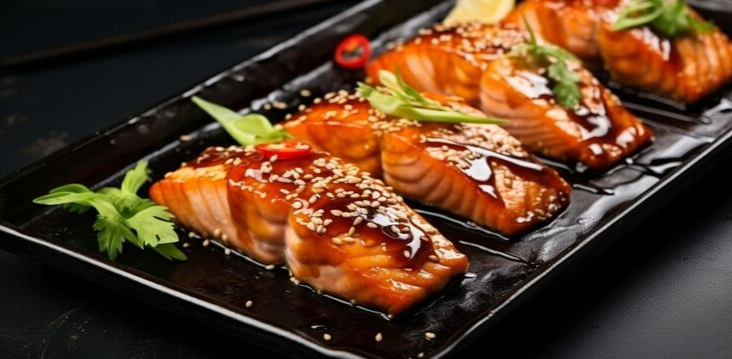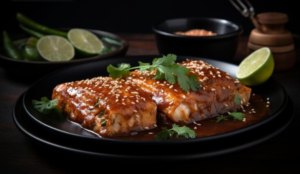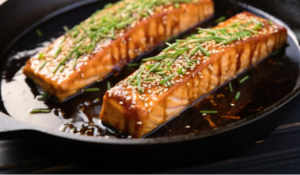Salmon Teriyaki: A Fusion of Traditional Japanese Flavors and Global Culinary Influence
what is salmon teriyaki made of? Salmon teriyaki is a beloved dish that blends the rich texture of salmon with the sweet and savory flavors of teriyaki sauce. This dish enjoys widespread popularity, appearing on menus worldwide, from its origins in Japan to international dining scenes. The appeal of salmon teriyaki lies in its delicious taste, ease of preparation, and nutritional value, making it a favored choice for many.
« Teriyaki » refers to a Japanese cooking method where food is broiled or grilled with a glaze of soy sauce, mirin, and sugar. The technique is perfect for salmon, allowing the fish to absorb the flavorful sauce while maintaining its moist texture. The tradition of teriyaki has evolved over centuries in Japan, originally used for various meats and fish. As it spread globally, salmon emerged as a particularly popular option, adapting well to the teriyaki style and reflecting a fusion of global culinary tastes with traditional Japanese practices. This evolution highlights salmon teriyaki’s cultural significance and its role in bridging diverse culinary worlds.
The Cultural Significance of Teriyaki in Japanese Cuisine
Teriyaki is more than just a cooking technique in Japan; it represents a significant culinary tradition that has influenced dining habits both in Japan and globally. This section explores the origins, evolution, and cultural impact of teriyaki, detailing its traditional methods and its journey to international fame.
Historical Origins and Traditional Methods
Teriyaki originated in Japan’s Edo period, primarily as a method for broiling fish. The name comes from ‘teri,’ meaning luster from the sugar glaze, and ‘yaki,’ meaning grilling or broiling. Traditional teriyaki involves marinating meat or fish in a distinctive sauce of soy sauce, mirin, and sugar, then grilling, broiling, or roasting to achieve a glossy, caramelized finish. This cooking technique enhances the natural flavors of the ingredients and adds a subtle sweetness that boosts the umami of the soy sauce.
Significance in Japanese Dining
In Japanese cuisine, teriyaki is a method that showcases the simplicity and elegance of the cuisine. It is used predominantly with ingredients that can benefit from the sweet and savory enhancement of the sauce, such as salmon, chicken, and beef. Teriyaki dishes are commonly served in Japanese homes and restaurants, often accompanied by steamed rice and pickled vegetables, reflecting the balance and harmony valued in Japanese dining.
Global Adaptation and Popularity
Teriyaki began its global journey post-World War II as Japanese cuisine started to gain popularity in the West. In countries like the United States, teriyaki has been adapted and embraced, evident in the variety of teriyaki-infused fast-food options and the incorporation of the sauce into local dishes. The simplicity of its preparation and the universal appeal of its sweet and savory flavor profile have made it a beloved choice in numerous other cultures, often modified with local ingredients and flavors to suit regional tastes.
Exploring the cultural significance of teriyaki not only enhances our appreciation of this cooking style but also illustrates how culinary traditions can transcend national boundaries, adapting to and enriching global cuisines. This section provides insight into how a simple cooking technique can evolve into a worldwide culinary phenomenon.
Ingredients of Salmon Teriyaki
Main Ingredients
Salmon: Types and Best Choices for Teriyaki The best salmon for teriyaki is fresh and high-quality, such as Atlantic, Sockeye, or King Salmon. These types are flavorful and have firm textures that hold up well during cooking. Fillets are ideal for even cooking and effective sauce absorption.
Teriyaki Sauce Components:
- Soy Sauce: Provides a deep umami flavor; opt for naturally brewed varieties for enhanced taste.
- Sugar or Alternatives: Traditional teriyaki uses sugar, but honey or maple syrup are great for adding a rich sweetness.
- Mirin: A sweet Japanese rice wine essential for authentic teriyaki sauce, contributing to the sauce’s caramelization.
- Garlic and Ginger: Freshly grated ginger and minced garlic add depth and a slight kick to the sauce.
Optional Ingredients and Substitutions
Gluten-Free Options Use tamari instead of soy sauce for a gluten-free teriyaki. Check that all ingredients like mirin are certified gluten-free.
Vegan Alternatives for Teriyaki Sauce Replace animal-derived ingredients like honey with plant-based sweeteners like agave syrup and use vegan « fish » sauce instead of soy sauce.
Adjustments for Dietary Restrictions
- Low-Sodium: Opt for low-sodium soy sauce to reduce salt intake without losing flavor.
- Sugar-Free: Use sweeteners like stevia or sugar-free syrups as sugar substitutes.
- Allergy-Friendly: Replace garlic or ginger with shallots or galangal if allergic.
These substitutions allow customization of salmon teriyaki to meet various dietary needs, ensuring it remains a versatile and accessible dish.
Preparation and Cooking Techniques
Preparation of Salmon
Cleaning and Filleting Before cooking, salmon must be properly cleaned and filleted. Start by rinsing the salmon under cold water to remove any debris. To fillet, place the salmon skin-side down and use a sharp knife to make a cut along the backbone, gently slicing the meat away from the skin. Remove any bones with tweezers.
Marination Tips and Duration Marinating salmon for teriyaki enhances its flavor. Mix the teriyaki sauce ingredients and coat the salmon fillets evenly. Allow the salmon to marinate in the refrigerator for at least 20 minutes but no longer than an hour to prevent the fish from becoming mushy due to the acidic components in the marinade.
Cooking Methods
Baking vs. Broiling: Pros and Cons
- Baking is straightforward and allows the salmon to cook evenly with minimal monitoring. It results in a moist, flaky texture but may lack a crisp outer layer.
- Broiling gives the salmon a caramelized top for added texture and flavor. It requires closer attention to prevent burning.
Stir-frying and Pan-searing Stir-frying salmon quickly cooks small pieces at high heat, ideal for incorporating vegetables and achieving a slightly crispy exterior. Pan-searing is best for creating a crusty surface on the salmon, locking in flavors and juices, typically done over medium-high heat until golden brown.
Air Fryer Instructions The air fryer offers a quick and healthy cooking method that provides a crisp texture. To cook, preheat the air fryer to 380 degrees Fahrenheit. Place marinated salmon in the basket, ensuring pieces don’t overlap, and cook for 8-12 minutes, depending on thickness. This method is excellent for achieving a broiled-like finish without the hassle.
Nutritional Information
Health Benefits of Salmon
Salmon is highly regarded for its exceptional nutritional profile, rich in omega-3 fatty acids, high-quality protein, and essential vitamins and minerals. Omega-3 fatty acids are crucial for heart health, helping to reduce inflammation and lower blood pressure. They also play a significant role in brain function and may decrease the risk of depression. The protein in salmon is complete, meaning it contains all essential amino acids necessary for muscle repair and growth. Additionally, salmon is a good source of B vitamins, particularly B12 and niacin, which are vital for energy production and maintaining proper nervous system function. It also provides important minerals like selenium, known for its antioxidant properties, and vitamin D, rare in foods and essential for bone health and immune function. Incorporating salmon into one’s diet offers a delicious way to derive a host of health benefits, supporting overall wellness.
Caloric Content of Teriyaki Sauce
- Teriyaki sauce is tasty but high in calories due to sugar and soy sauce.
- It typically has about 15 to 30 calories per tablespoon, mostly from carbohydrates.
- When making salmon teriyaki, consider the sauce quantity for those watching their calorie intake.
- To fit a balanced diet, reduce the sugar in the sauce or use natural sweeteners like honey or maple syrup.
- These alternatives may have fewer calories and a lower glycemic index.
- Use the sauce moderately to keep the dish flavorful yet calorie-conscious.
- For a healthier meal, pair salmon teriyaki with steamed vegetables and whole grains for a balanced, nutritious plate.
Serving and Presentation
Serving Suggestions
Salmon teriyaki pairs well with various sides to enhance its flavors. Steamed rice is a traditional choice, absorbing the savory sauce and contrasting with the tender salmon. For a healthier option, consider brown rice or quinoa, and accompany with vegetables like steamed broccoli or a crisp salad. Soba or udon noodles also make great sides, offering a satisfying texture that complements the dish.
For presentation, arrange the salmon on a bed of rice or noodles, surround it with vegetables, and drizzle some teriyaki sauce over the top for extra flavor and a glossy appearance. Garnish with sesame seeds or sliced green onions to add sophistication and color.
Storage and Reheating
To keep salmon teriyaki fresh, store it in an airtight container in the refrigerator for up to two days, or freeze for up to three months. For reheating, thaw in the fridge if frozen, then warm in the oven or on the stove. Cover with foil and heat at 275°F (135°C) to preserve moisture and texture. Avoid the microwave to prevent drying out the fish. Proper reheating ensures the dish remains delicious and enjoyable.
FAQs
Common Queries about Salmon Teriyaki
Can I use frozen salmon?
Yes, frozen salmon can be used for making teriyaki. It’s a convenient option and can be just as tasty if prepared properly. To use frozen salmon, ensure it’s thoroughly thawed before marinating or cooking. Place it in the refrigerator overnight or use cold water for a quicker thaw. This step is crucial to achieve even cooking and the best texture.
How long can I marinate the salmon?
For the best flavor, marinate the salmon for at least 20 minutes, but no more than an hour. Marinating for too long can cause the fish to become mushy due to the acidic components in the teriyaki sauce, such as mirin or vinegar. If you’re short on time, even a brief 20-minute marination can infuse the salmon with enough flavor to make a delightful dish.
Are there any quick preparation tips?
To speed up the preparation of salmon teriyaki, focus on the following tips:
- Prep in advance: Prepare the teriyaki sauce in advance and store it in the refrigerator. You can make a larger batch and keep it for several weeks.
- Pre-cut ingredients: Chop any additional ingredients like garlic, ginger, or garnishes beforehand and store them in the fridge.
- Use thin fillets: Opt for thinner salmon fillets or cut them into smaller pieces to reduce cooking time.
- High heat cooking: Use methods like broiling or pan-searing over high heat to cook the salmon quickly while still achieving a deliciously caramelized exterior.
These FAQs cover basic concerns about using frozen salmon, marination times, and quick preparation methods to help ensure your salmon teriyaki is both delicious and easy to prepare.
Variations of Salmon Teriyaki
Exploring variations of salmon teriyaki allows for customization according to personal tastes or to adapt to different cultural influences. This section will delve into how different ingredients and cooking techniques can transform the traditional recipe, offering new flavors and experiences.
Different Spices
Adding spices to the teriyaki sauce or as a seasoning for the salmon before cooking can introduce new flavor profiles. For example, adding a pinch of cayenne pepper or a touch of ground ginger can enhance the sauce’s warmth, while a sprinkle of toasted sesame seeds adds a nutty flavor and texture.
Alternative Fish Types
While salmon is traditional for teriyaki, other types of fish can also be used effectively. Examples include tilapia, cod, or even sea bass, offering different textures and flavors. Adjust cooking times and techniques depending on the fish’s thickness and fat content to ensure optimal results.
Unique Garnishes
Garnishes not only enhance the dish’s flavor but also its visual appeal. Options like thinly sliced green onions, a wedge of lime for a citrusy zest, or a sprinkle of chopped cilantro can add fresh, vibrant flavors. For a richer experience, drizzle a creamy, spicy mayo over the top before serving.
These variations encourage experimentation and personalization, making salmon teriyaki a versatile dish suitable for a variety of dietary preferences and occasions. Whether adapting the dish to fit dietary restrictions or simply to enjoy a different taste, these ideas offer creative ways to enjoy this classic dish.
Expert Tips for Perfecting Salmon Teriyaki
Achieving restaurant-quality salmon teriyaki at home can be straightforward with guidance from culinary experts. This section gathers professional advice on perfecting the dish in terms of cooking techniques, flavor balancing, and presentation, ensuring that even novice cooks can create a delectable meal.
Optimal Cooking Temperatures
- Experts suggest cooking salmon at medium-high to caramelize the outside while keeping the inside moist and tender.
- The ideal internal temperature for salmon is 125°F to 130°F (about 52°C to 54°C), achieving a medium cook with a slightly translucent center.
- Use a cooking thermometer to ensure precise temperature control.
- Preheat the pan or grill to ensure the salmon begins cooking immediately upon contact, which helps seal in the flavors.
Sauce-to-Salmon Ratios
Balancing the sauce-to-salmon ratio is key to avoiding overpowering the natural flavors of the fish. A general guideline is to use about three tablespoons of teriyaki sauce per pound of salmon. Applying the sauce in layers as the salmon cooks can also enhance the flavor; brush a light layer on before cooking, add another during cooking, and a final glaze just before serving. This method allows each layer to caramelize and build up a rich flavor profile without the sauce becoming too soggy or burnt.
Plating Techniques
Presentation is crucial in Japanese cuisine and can make a significant difference in how a dish is perceived and enjoyed. To plate salmon teriyaki like a pro, place the salmon on a clean, white plate for contrast. Drizzle a small amount of extra sauce over the top, allowing it to pool slightly around the fish but not enough to make it soggy. Garnish with a sprinkle of sesame seeds and a few thin slices of green onion or a small bunch of microgreens. This not only adds color and texture but also a fresh flavor to complement the rich teriyaki.
With these expert tips, home cooks can elevate their salmon teriyaki, turning a simple meal into a gourmet experience. These suggestions not only improve the cooking process but also enhance the overall dining experience by focusing on details that contribute to flavor, texture, and presentation.
Enhancing Connectivity with Internal Links
Choosing Fresh Salmon: Embed a link at the mention of « selecting the right ingredients » in the introduction or wherever fresh salmon selection is discussed. This link leads to a guide on how to select the best fresh salmon. Use the URL: Choosing Fresh Salmon
Homemade Teriyaki Sauce Variations: Add a link at the phrase « exploring sauce variations » within the section on customizing the teriyaki sauce. This directs to various homemade teriyaki sauce recipes. Use the URL: Homemade Teriyaki Sauce Variations
External Resources and References
- Salmon Teriyaki Gets Back To Its Roots:
- Embed this link at « Teriyaki’s roots reach all the way back to Japan’s Edo period » in the historical context section of your article. This link provides a detailed exploration of the traditional methods of teriyaki and its evolution.
- The Origins of Teriyaki: Tracing its Roots and Cultural Significance:
- Embed this link at « cultural significance of teriyaki in Japanese cuisine ». It offers an in-depth look at how teriyaki has influenced cultural culinary practices from Japan to global kitchens.
- HISTORY OF TERIYAKI (1813-2022):
- Place this link at « the evolution of teriyaki » within the section discussing how teriyaki has been adapted worldwide. This source provides a comprehensive historical timeline and cultural analysis.
Understanding the Core of Salmon Teriyaki
In summarizing this popular dish, one might ask: what is salmon teriyaki made of? Essentially, it blends salmon’s rich texture with a glaze of soy sauce, mirin, and sugar. This Japanese cooking technique lets salmon absorb deep, sweet-savory flavors while staying moist and tender. The outcome is a dish celebrated not only for its delicious taste and ease of preparation but also for its nutritional benefits, making salmon teriyaki a favored choice worldwide.



